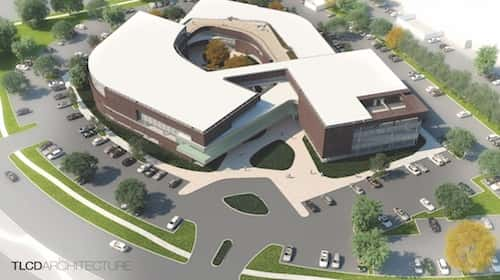
The Great Recession took a toll on many industries, with the downturn cutting a swath of growth and stability out of national, state and local economies. One of the hardest hit sectors in the North Bay was the business of building. In Marin, Sonoma and Napa counties, building usually employs thousands of construction workers along with tradespeople such as plumbers, painters, cement specialists, heating/cooling experts and more. A downturn in construction projects doesn’t just affect the people swinging hammers, it also impacts developers, architects, mortgage brokers, banks, land surveyors and insurance companies.
Keith Woods, chief executive officer of the North Coast Builders Exchange, has his finger on the pulse of what’s happening in the building industry. His member operated, nonprofit organization represents more than 1,100 contractors, architects, engineers and other firms involved with the construction industry in Sonoma, Napa, Mendocino and Lake counties.
The three elements of construction that drive the local trade are new residential, industrial/commercial and remodeling/improvement. When home values plummeted in Sonoma County, dropping from a median of $615,000 down to $320,000, homeowners were no longer able to access their equity and the remodeling arm sputtered to a near stop between 2007 and 2014, hurting smaller construction businesses that made a living remodeling kitchens or adding an extra room to a house. Now that home values are on the rise, home improvement projects are also picking up.
Commercial and residential building has rebounded as well, with ground being broken across the North Bay for winery expansions, hotels, retail centers, single-family homes and multi-unit apartment complexes. According to the county of Sonoma Permit and Resource Management Department, 7,100 new permits for construction in unincorporated Sonoma County were issued in 2006. After 2006, the number of permits issued started to dip, with a low of 5,200 permits issued in 2009. In 2013, permits issued started to climb again and, in 2015, a robust 6,874 permits were granted, demonstrating a rebound in construction activity.
Artistic and state-of-the-art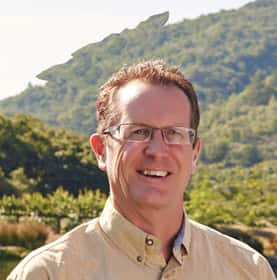
One of the larger post-recession building endeavors in the North Bay is the American AgCredit project near the Charles M. Schultz – Sonoma County Airport in Santa Rosa. American AgCredit is a provider of agricultural loans, leasing and insurance services across six western states. It awarded the development of its new nation headquarters to TLCD Architects and Jim Murphy and Associates.
Steve Ronchelli, vice president of JMA, explains that the bidding and evaluation process for this project was very unique. “Initially, 10 construction companies and 10 architecture firms were contacted and invited to provide their qualifications. Of the initial 20 candidates, five were selected on each side [architecture and construction] and challenged to join up and provide a ‘paired’ proposal to American AgCredit. TLCD Architects and Jim Murphy Associates accepted the challenge and was subsequently awarded the joint bid on the project.”
While there are still some tenant improvements wrapping up, the project was completed on schedule, and the first American AgCredit employees moved in around Thanksgiving 2015. “Aside from the distinctiveness of the selection process, there are many other aspects of this construction that set it apart from other projects,” says Ronchelli. “The size in itself—120,000 square feet—makes it large for office space in this area. Additionally, all the floors are raised 18 inches above the structural foundation, meaning air and wiring can be configured entirely to the tenants’ desire. And most of the internal walls are demountable and movable, further enhancing the flexibility of the layout.”
Some other facts about the construction include the use of 7,500 cubic yards of concrete; 2,886,000 pounds of structural steel; 51,707 square feet of glass; more than 1 million feet of copper wire; 2,400 LED light fixtures (there not one single light bulb in the entire building); 204 automated, motorized window shades; and materials from eight different countries. Jesse Gladman, JMA general superintendent, and Jerry Stine, assistant superintendent, are quick to point out that one of the coolest features of the building is the ‘rammed’ wall in the lobby area. This wall is two feet thick and consists of cement and dirt. The dirt was collected from each of the geographic areas where American AgCredit is represented (for example, red dirt for New Mexico) and is layered to create a work of art.
 It’s not the only place in the stunning building where art is featured. A wall covered with wine barrel staves looks like something you might see in an upscale restaurant. A wall covered in a mosaic made from cowhide tiles, shaded in soothing tones of beige, various browns, forest and moss green, was imported from Italy and could easily be the focal piece at a museum. The emphasis isn’t just on beauty, though. Each working aspect of the building was designed with sustainability and functionality in mind.
It’s not the only place in the stunning building where art is featured. A wall covered with wine barrel staves looks like something you might see in an upscale restaurant. A wall covered in a mosaic made from cowhide tiles, shaded in soothing tones of beige, various browns, forest and moss green, was imported from Italy and could easily be the focal piece at a museum. The emphasis isn’t just on beauty, though. Each working aspect of the building was designed with sustainability and functionality in mind.
An elaborate cooling system uses water as its mainstay; floor-to-ceiling window shades are activated to lift and lower based on the position of the sun; smart lights turn on when someone enters a workspace and also dim or brighten as sunlight affects a room to minimize the use of electricity. The patterned grey carpet is not just stylish, it’s made from recycled fishing nets, making it durable and ecologically friendly.
Constructing a building of such magnitude was no small feat. It took crews of 100 to 150 workers,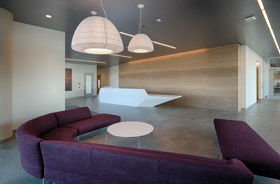 sometimes working seven days per week, 10 hours per day, 18 months to complete the project. That hard work paid off. “We made the deadline by four weeks,” says Gladman proudly.
sometimes working seven days per week, 10 hours per day, 18 months to complete the project. That hard work paid off. “We made the deadline by four weeks,” says Gladman proudly.
The American AgCredit building has been a great success for JMA, but it’s not the firm’s only significant undertaking over the past few years. Ronchelli says, “The commercial side of our business has seen significant growth starting in 2012. While 2005 to 2007 were the glory days, the entire industry took a hammering during 2008 to 2011. There was so much empty and available commercial space that there was no need for new construction.” Since 2012, JMA has experienced steady growth tied to banks’ willingness to lend again and the cost of money (aka interest rates) being favorable. 2016 is shaping up to be a very good one for the firm and the outlook for 2017 is also very positive. “Geographically, the Santa Rosa Airport Business Park is surging because it’s the stage one endpoint for the SMART train. We expect increased traffic at the airport since Sonoma and Napa are such hospitality destinations, which will also contribute to the surge in this particular area,” adds Ronchelli.
On the retail side of the business, Ronchelli says, “Our retail business is targeted specifically towards the upper end of the market, and we didn’t experience much negative impact, if any, during the recession. We’re pretty much running at 100 percent in this sector regardless of the general economic condition.” Ronchelli emphasizes that, “While gross growth has been very good over the past few years, the quality of the work is as important as the quantity. We prefer to do the right work, but we equally prefer to do the work right.”
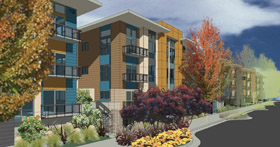 Affordable family housing
Affordable family housing
With occupancy rates at record highs, it’s difficult at best for low-income families to find reasonably priced housing. One group that’s struggled in this area is work-authorized farmworkers. In a region where agriculture thrives, there must be people to harvest the bounty. According to a 2015 survey by the Sonoma County Health Department, the profile of farmworkers in the area is changing. Almost 90 percent of workers now living in Sonoma County reside here permanently and spend up to 60 percent of their income on rent. Because the workers live here on a year-round basis, their families live with them.
On June 17, ground was broken for the Ortiz Family Plaza, a 30-unit complex in Santa Rosa designed by Hedgpeth Architects to fill a critical need. The two bedroom, one-and-a-half bathroom apartments will provide clean, safe and affordable homes for workers and their families. The two-story buildings were designed to match the residential feel of the surrounding area. The buildings will encircle a community center with laundry facilities, a management office, kitchen, covered patio, barbecue and picnic area, a playground, community gardens and a teen recreation area. Onsite services such as English as a Second Language, citizenship workshops, mentoring programs and more will also be offered.
As development partner-owners, California Human Development, Phoenix Development Company, the lead developer, and Integrity Housing had to secure the nearly $11 million needed to complete the project. “The financing structure for Ortiz is complicated,” says Loren Brueggemann, principal of Phoenix Development Company. “There’s a significant challenge on the cost side of affordable housing to make it cost effective.” However, Brueggemann says, local community leaders, as well as state and federal organizations, understood the need for this type of housing. A diverse group of funders came together to make the project a reality, including the U.S. Department of Agriculture Rural Development, Sonoma County Development Commission, City Real Estate Advisors, California Housing Finance Agency, American Ag Credit, Marv Soiland, Community Foundation Sonoma County, Sonoma County Grape Growers Foundation, Jackson Family Wines & Enterprises, Exchange Bank, California Community Reinvestment Corporation, Sonoma County PRMD, Rural Community Assistance Corporation and Century Housing.
“The investment in housing for farmworkers is a long-term one that parallels the plans winegrowers are making for sustainability for the next 30 to 40 years,” says Christopher Paige, CEO of California Human Development. He notes that a vibrant agricultural community will always need a workforce—and that workforce will always need affordable housing. “In the end, everyone benefits from sustainable agriculture,” says Paige. “Even the open space here is, to some degree, a result of viable agriculture, helping to maintain the beauty of Sonoma County.”
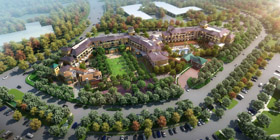
Meritage Commons
One of the larger construction projects taking place in Napa Valley is the expansion of The Meritage Resort and Spa to include Meritage Commons. The Meritage Resort and Spa, winner of NorthBay biz’s 2015 Best Spa /Resort, is considered one of the premiere getaway spots in the North Bay. With its 322 beautiful rooms, including 12 lush suites, demand is ever increasing as it becomes known throughout the country as a travel destination. The Meritage Commons expansion is a $100 million undertaking aimed at further enhancing customer experiences by bringing Napa directly to guests in an all-encompassing luxury package.
With an upswing in demand for accommodations, ground was broken earlier this year on Meritage Commons, with a completion date estimated for 2018. General Manager Michael Palmer says, “Meritage Commons will be built on 9.5 newly acquired acres across the street from the original resort. The expansion will provide an additional 145 guest rooms and suites.” Each new guest room will be 400 square feet or larger, and each of the 39 suites will be in excess of 800 square feet. There will also be an outdoor pool area and a food and wine village. The village will include a gourmet inspired market and shop with a delicatessen featuring sandwiches, salads, pour-over coffees, cheeses, sweets and more for sampling all the goodies that Napa Valley has to offer in addition to wine.
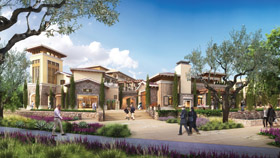 The four-story Meritage Commons will introduce new amenities for guests and locals including approximately nine tasting rooms, an expansive event lawn for social gatherings, concerts and a demonstration kitchen. Trinitas Cellars, and Foley Family Wines are among the wineries set to have a tasting room onsite. One of the driving forces behind the layout and design of the new property is to be one with nature, and the expansive surrounding property with acres of hiking trails and vineyards is sure not to disappoint.
The four-story Meritage Commons will introduce new amenities for guests and locals including approximately nine tasting rooms, an expansive event lawn for social gatherings, concerts and a demonstration kitchen. Trinitas Cellars, and Foley Family Wines are among the wineries set to have a tasting room onsite. One of the driving forces behind the layout and design of the new property is to be one with nature, and the expansive surrounding property with acres of hiking trails and vineyards is sure not to disappoint.
“The sun and its movement across the sky play an essential role in the Meritage Commons project. We’ve worked to integrate the buildings and the vineyards with how the sun sets and rolls,” says Palmer. “Our guests’ views and experience at both The Meritage Resort and Meritage Commons are very important to us.”
Palmer says that what meets the customer upon arrival is vital to this experience. “It’s crucial that we do it right from the get-go and promote the beauty of Napa Valley from the very first exposure to the resort with the sun again being the focal point.” Roughly 65 percent of the resort’s expansion business will be group related, but should guests be inclined to venture beyond the resort and spa, they can easily do so with the help of a 27-passenger luxury shuttle.
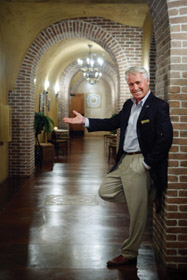
Marin projects underway
By mid-year 2012 and into 2013, Rick Wells, CEO of the Marin Builders Association, saw an increase in activity for the organization’s members and for the county in general. “Local commercial vacancy rates were dropping, and we began to see the subsequent uptick in tenant improvements,” says Wells when asked what some of the indicators were that building was rebounding. Wells says that residential real estate values and activity began to climb and a greater number of homeowners began to invest in their primary residences with improvements and remodels.
“Our members told us that they weren’t having to look for work. They told us, ‘Work is finding me.’” More often, Wells started to hear contractors say they were having trouble finding enough qualified workers. “We also saw an increase in public bid requests for civic-related public projects from the county and our municipalities across Marin,” says Wells.
These days, most of the construction Wells is seeing is in one of three categories: infrastructure, commercial tenant improvements and a wide scope of residential remodels. There are also some large-scale commercial projects in the works. One of these is taking place at the San Rafael Corporate Center, where BioMarin is in the middle of an expansion. There also continues to be activity around the Novato narrows and other parts of Highway 101.
In Marin, Wells anticipates SMART-related construction to steadily increase over the next several months. “Most of the building we see or hear about for SMART is still primarily in the preparation stages,” says Wells. He believes development around train stops will depend on the success of SMART establishing and increasing ridership. “Economic activity tends to gravitate toward a consistent and engaged base of potential customers,” says Wells.
Bruegemann, who’s planning to build 72 luxury apartments, called Pullman Lofts (also with Hedgpeth), in Santa Rosa’s Historic West End near one of the SMART stops, also believes more planning and building will take place once SMART is operational. Traditionally rapid transit systems have tended to be magnets for development, and local developers anticipate that once SMART is in operation, more transit-oriented development will begin to take shape.
 What’s next?
What’s next?
“There are projects in the pipeline that should sustain the industry for the next three to five years. After that, who knows what will happen,” says Woods. Building is a vital force in the local economy, creating employment opportunities for thousands of workers in the trades as well as having a positive ripple effect on other sectors. “For the most part, the indicators are positive in Marin, but as we all know, there are many forces that influence our local economy and our building market—including interest rates, politics and emergent technologies,” says Wells.
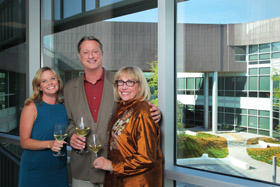
Sonoma County’s Trio
The new American AgCredit building houses not only the corporate headquarters for this essential agricultural financial institution, it also serves as the base for three of Sonoma County’s hospitality and wine advocacy groups: Sonoma County Tourism, Sonoma County Vintners and Sonoma County Winegrowers. The three organizations have shared the same roof for the past 10 years and, like the fine wines and foods of Sonoma County, they’ve always paired well with one another. However, leasing office space in American AgCredit’s new sustainable and state-of-the-art structure has brought them even closer together. All three organizations are in the business of showcasing and nurturing the finest treasures Sonoma County has to offer, and it makes sense that, although they’re run as separate businesses with different boards of directors, it’s easy for them to support the goals of one another.
In March 2016, the “Trio” moved into their new offices just as the building was being finished. “It’s been wonderful being in the new space,” says Jean Arnold Sessions, SCV executive director. “The space we’re in is inviting and very light.” The three businesses are housed in the same part of the building with SCV and SCW occupying a second floor space. SCT is right below on the first floor, where the Trio’s shared conference room and employee kitchen is also located.
Karissa Kruse, SCW president, says, “We’re excited and honored to be included as the first tenants. The space is beautiful and very focused on being sustainable, which is such a great fit with our grapegrower sustainability commitment.” Not only does the new space allow the Trio to stay together, Kruse notes it’s a dream office space because American AgCredit was able to meet all their special requirements including ample storage, meeting and office space that supports team collaboration.
All three of the organizations share a New York City public relations agency, and there’s some staff overlap with a receptionist that supports all three groups. Sometimes, members from different Trio businesses travel together to promote Sonoma County and Sonoma County produced goods. The formal collaboration is made easier by the close proximity of their offices, which lets staff members meet with one another easily and often, pop into one another’s offices informally with a thought or a question, or to run into each other in the lunchroom or outdoor courtyard (often spurring on an impromptu work-oriented conversation). “We get more done together—and raise the bar—when more people with differing skill sets and dynamics are involved in the conversation. It’s great to have members of all three organizations around to spark energy and start brainstorming sessions. It makes our work more fun and stimulating,” says Kruse.
Ken Fischang, President/CEO of Sonoma County Tourism says “We are so grateful to American Ag credit for their investment in Sonoma County tourism, Sonoma County vintners and Sonoma County wine growers new offices. We spent over two years working with American Ag credit and TCLD architecture designing this amazing space.”
This sort of camaraderie prompted staff to repurpose the serving bars made for Super Bowl 50 (ones used to promote Sonoma County at the sports event); they now occupy a space where the Trio hosts a monthly “happy hour” for staff, board members and partners.
Trio staff members are also impressed with the technology that’s been incorporated into the building, including super fast Wi-Fi connections, automatic window shades and lighting that reacts to direct sunlight, as well as the overall feel of being in a “green” office building. “When the doors are closed, the offices are nearly soundproof,” says Sessions. Twelve-inch think channel glass panels make it possible to move offices around and change their configuration while preserving the soundproof aspect. One old-fashioned feature that’s much appreciated by Trio staff members are the offices that contain an entire wall of magnetic white board. The Trio agrees American AgCredit is a great landlord and that this new space is the best they’ve ever occupied. Soon, there will be a café and a few new neighbors in the building and everyone’s looking forward to the new additions.


